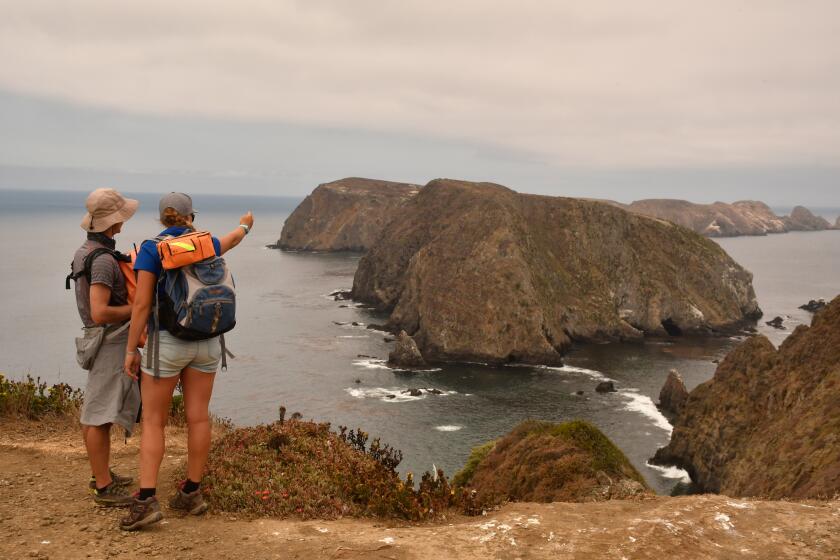Lawmakers revive effort to expand Santa Monica Mountains recreation area

- Share via
- A U.S. Senate bill calls for adding more than 118,000 acres to the Santa Monica Mountains National Recreation Area, a unit of the National Park Service.
- The park service faces a roughly $1.2-billion funding cut under Trump’s proposed 2026 budget.
California’s federal lawmakers are reviving plans for a vast expansion of the Santa Monica Mountains National Recreation Area, but the effort comes as the Trump administration seeks funding cuts that some fear could lead to the area being severed from the National Park system.
Legislation recently reintroduced by U.S. Sen. Adam Schiff (D-Calif.) would add more than 118,000 acres of what is known as the Rim of the Valley corridor to the roughly 154,000-acre recreation area, dubbed the world’s largest urban national park. U.S. Rep. Laura Friedman (D-Glendale) plans to introduce the House version.
The Rim of the Valley corridor is a noncontiguous area that stretches from the Simi Hills and Santa Susana Mountains to the Verdugo and the San Gabriel mountains, creating a “green belt” that encircles the San Fernando, Crescenta, Santa Clarita, Simi and Conejo valleys. It also encompasses existing parks and historic sites, including Griffith Park and Olvera Street in Los Angeles.

Proponents say the legislation, if successful, would pave the way for cohesive management of the expansive area, as well as access to federal funding and expertise. It could lead to the protection of wildlife corridors — for mountain lions, bears and other local critters — as well as better maintenance of trails.
“What this is intended to do is to open up access into our national forest and state parks for the public,” Friedman told The Times. “So you add land, but you also add a lot of connectivity by doing this so that people could enjoy those public spaces more easily.”
A National Park Service spokesperson declined to comment.
It’s not a new effort. In fact, elected officials and environmental activists have sought to protect the Rim of the Valley corridor for decades. Similar legislation failed last year.
The latest iteration comes as the Trump administration seeks to slash about $1.2 billion in funding for the National Park Service, or roughly 30% of its operating budget, in the coming 2026 fiscal year, including $900 million for park operations.
In proposing the cuts, the administration has called for ceding certain federal parklands to the states.
The park service’s responsibilities “include a large number of sites that are not ‘national parks,’ in the traditionally understood sense, many of which receive small numbers of mostly local visitors and are better categorized and managed as state-level parks,” the discretionary budget request states. “The budget would continue supporting many national treasures, but there is an urgent need to streamline staffing and transfer certain properties to state-level management to ensure the long-term health and sustainment of the National Park system.”
According to an analysis by the National Parks Conservation Assn., a nonpartisan membership organization dedicated to protecting national parks, the envisioned cuts would lead to the evisceration of at least 350 of the 433 areas managed by the park service across the country.
Dennis Arguelles, the organization’s Southern California director, said he anticipates that most funding would go to “marquee parks” such as the Grand Canyon, Yellowstone and Yosemite if the cuts go through.
“Parks like the Santa Monica Mountains National Recreation Area would be at risk,” he said.
“Only Congress has the power to ultimately dispose of federal property and sell it, or give it back to the states, or whatever they are talking about doing,” Arguelles added. “So the president, this administration, may have that intention, but ultimately Congress would have the last say — or should have the last say.”
The budget is just one of several threats to national parks that have emerged in recent months.
In February, roughly 1,000 National Park Service employees were laid off as part of the Trump administration’s push to shrink the federal workforce — including about eight workers from the Santa Monica Mountains National Recreation Area. Court orders reversed the layoffs, but many believe more jobs will be cut.
Since January, the National Parks Conservation Assn. estimates, the park service has lost about 13% of its staff due to pressured buyouts, early retirements and deferred resignation.
The buyouts and the Feb. 14 firing of probationary employees has cost the National Park Service at least 1,700 permanent staff members this month, roughly 9% of its workforce.
Jim Hines, a Ventura County-based activist dedicated to protecting public lands, waters and wildlife, has been sounding the alarm about the vulnerability of the Santa Monica Mountains National Recreation Area. In an informal mid-May email newsletter that Hines says goes out to nearly 10,000 people, he said the recreation area was “DOGE Target Number One,” referring to the the Department of Government Efficiency formerly led by Elon Musk.
There’s a lot to lose, he wrote in his newsletter, including open space and recreation opportunities in the densely populated Los Angeles area.
In an interview, Hines said he regularly travels to Washington, D.C., and meets with his “adversaries,” including Trump administration officials carrying out DOGE directives; he’s been there five times since Trump began his second term.
Outside of a handful of representatives with ties to Southern California, members of Congress haven’t heard of the recreation area, he said.
“Time to let everyone, everywhere know the importance of the Santa Monica Mountains National Recreation Area ... I have started with the Trump/DOGE Administration ... now the ball is over to YOU,” he wrote in the May 12 newsletter.
Hines believes the vision for the Rim of the Valley corridor, which he supports, will one day be realized — but not this year. He said the latest bill has a “minus zero” chance of passing.
An effort to add 118,000 acres to the Santa Monica Mountains National Recreation Area is coming to a head in Congress. Here’s why you should support it.
The concept for the Rim of the Valley corridor was born out of the late Marge Feinberg’s master’s thesis in the mid-1970s, in which the Cal State Northridge graduate student envisioned a long-distance trail surrounding the hills and mountains of the San Fernando Valley.
Over the years, politicians and conservationists have taken up Feinberg’s cause.
In 1990, Republican Gov. George Deukmejian green-lighted the completion of a master plan of the Rim of the Valley trail corridor, but that didn’t result in widespread action.
During the George W. Bush administration, Congress financed a study of the Rim of the Valley, which the park service completed in 2016. A bill then wound its way through Congress during the Trump administration, passing in the House but dying in the Senate.
Previous iterations of legislation would have added 191,000 acres to the Santa Monica Mountains National Recreation Area. Facing backlash from developers and construction lobbyists, those bills never took.
Any land that was zoned residential or commercial, or that was already developed for those purposes, was removed from the proposal. What’s left is land already protected at the local level.
Schiff’s involvement with the effort dates back at least 17 years.
“The Rim of the Valley contains some of the last wild and open spaces in Los Angeles and connects our urban city centers and suburbs with the beautiful outdoors,” Schiff said in a statement. “This legislation will preserve the land and wildlife that millions of Angelenos enjoy.”
Arguelles, of the National Parks Conservation Assn., said the practical effect of the legislation can be gleaned by looking to the Santa Monica Mountains National Recreation Area, where the National Park Service owns and manages only about 15% of the land. The recreation area’s federal status doesn’t strip local jurisdictions of control, he said. Instead, it allows the park service to work with other land managers — including state and local agencies — to restore native vegetation, study trail networks and complete other complex projects.
A more than 20-year study on mountain lions in and around the Santa Monica Mountains, for example, is led by the National Park Service. That research has shed light on existential threats facing the big cats eking out an existence in an increasingly urbanized landscape.
“That’s what they could do in these other areas, by being able to apply their resources and their expertise,” Arguelles said.
Even if the bill gets “bogged down” in D.C., he said, introducing it helps keep the issue alive at the local level.
Times staff writer Jaclyn Cosgrove contributed to this report.









